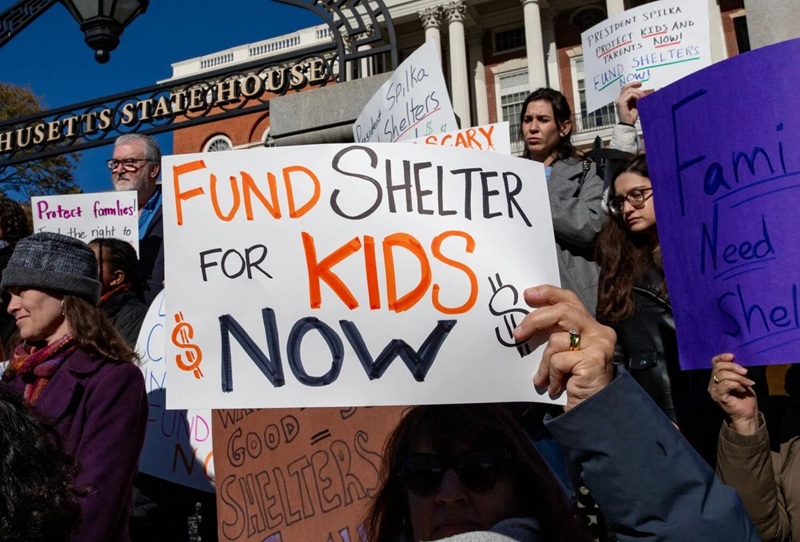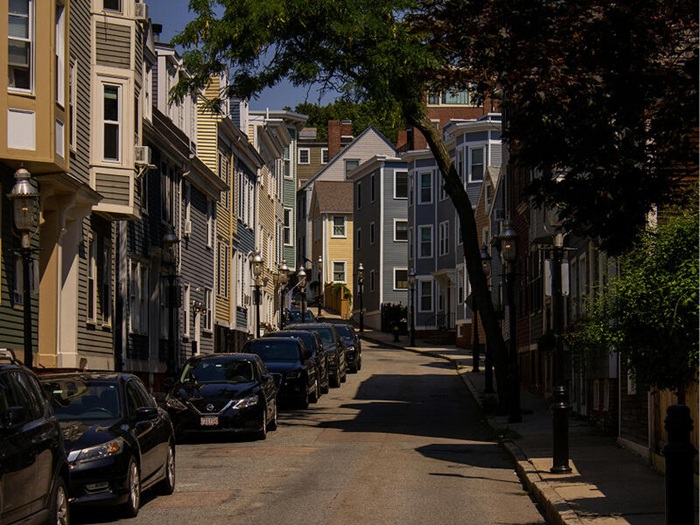Governor Healey’s Mixed Messages On Housing For Those Most In Need
Her broad housing initiative is laudable, but limiting shelter stays moves things backward
As a family medicine physician at Boston Medical Center, I have cared for hundreds of individuals and families experiencing homelessness over the last 20 years.

Advocates rally on the State House steps on October 31, 2023, calling for the state to abide by its right to shelter law for migrant families and for lawmakers to approve additional money for the emergency shelter system. (Photo by Sam Doran/State House News Service
The landscape of housing services that I can offer them continues to change, sometimes leaving me with a great sense of hope and possibility and, at other times, more hopeless than ever for my patients’ restoration to health.
Recently, this seesaw from hope to hopelessness has become more extreme, as decisions by our state leaders seem to be simultaneously pulling in opposite directions when it comes to housing help for those most in need. Two families for whom I provide medical care illustrate the mixed messages of our state’s recent housing policies affecting the state’s most vulnerable residents.
The first is a husband-and-wife couple in their seventies. I have cared for them both for over 10 years, and while they have both suffered a litany of medical concerns, the husband has been particularly unwell. He came to me with a history of long, uncontrolled high blood pressure and diabetes with an ensuing heart attack and stroke. He also was suffering from an untreated substance use disorder, which helped him paper over his years of untreated anxiety and depression.
One saving grace when I met him was that he had a safe and stable place to live. From that fundamental base, we could begin to build back his health — delivering medications to his doorstep, connecting him to community services, and treating both his behavioral health concerns and substance use.
Seven years ago, however, this fundamental base disappeared when he lost his housing. Three years into retirement, he no longer had enough savings for a home. Ironically, he was a retired construction foreman from Boston, where throughout his 30-year career, he had poured his talent into building homes in Roxbury and Dorchester.
Despite years of working with incredible housing advocates, my patient and his wife have not been able to find a stable place to live and continue to sleep on loved ones’ couches in a distant Boston suburb. As a result, his health has begun to rapidly deteriorate again. It is harder to come in for appointments, to receive his medications when he does not know where he will next be sleeping, and to keep his diabetes medications in the fridge or his diet filled with fresh fruits and vegetables.
However, in the last few months, things have begun to look at least a little more hopeful for this gentleman and patients like him. Early this year, Gov. Healey released “A Home for Everyone,” the state’s first comprehensive plan to address Massachusetts’s housing challenge. The plan aims to build 200,000 new housing units by 2030. This ambitious goal came a year after the governor signed the Affordable Homes Act, which authorized more than $5 billion in spending and included nearly 50 policy initiatives to spur more housing. In addition, three new commissions have been established to prioritize the residents of these future homes: elderly, extremely low income (earning less than 30 percent of the median income), and individuals with disabilities (physical, sensory, intellectual, mental health or neurodivergent).
My patient and his wife fit squarely into all three of these categories. Though the housing needs among these groups far outstrip the available supply, since the launch of these state initiatives, I have begun writing letters advocating that, given his medical conditions, he cannot be living with unstable housing — this time with greater hope that these letters will make an impact.

For another family in my care struggling to find stable housing, the situation has not turned hopeful, but is, in fact, more grim as a result of recent actions by state government.
They first came to me for a prenatal visit. New to Massachusetts, nobody in the family had a primary care provider and, seeing their complex social needs, I agreed to have all family members (the mother, father, older sibling, and soon to be infant) establish care with me that day.
When they moved to Massachusetts, this family was able to benefit from our strong 40-year precedent of the “right to shelter” law, signed by Gov. Dukakis in 1983, that mandated shelter services for parents with children and pregnant women.
Partnering with incredible organizations such FamilyAid, homeless families have been able to find shelter and transition to housing. Through the safety of stable shelter, the mother in this family was able to expend her energy finding and receiving adequate prenatal care — yielding the best possible outcomes for both the newborn and her future health.
The parents were also able to start securing employment resources as well as educational support and starting to get back on their financial feet. Like many families living in Boston, this one was living on meager wages (though did not qualify as extremely low income).
Boston, surprisingly perhaps for some, carries the unenviable statistic of having the fifth largest number of families living in poverty among 30 of the largest US cities, with poverty levels 65 percent higher than the national average. This translates to the third highest rate and the fifth highest number of homeless families among comparable large cities. However, the “right to shelter” has now been dismantled through a recent set of mandates from the Healey administration, limiting the number of shelters available (from a high of 7,500 family shelter units in 2023 to 4,000 units by 2026) as well as imposing a six-month maximum stay in shelters.
These new rules place this family, and thousands of families like them, at dire risk. In addition to the devastating health outcomes for adults experiencing homelessness, children who are homeless are also at high risk for a myriad of downstream health outcomes. These include such concerns as higher adverse childhood events, higher risk of future behavioral health illness such as depression and suicide attempts, higher rates of future substance use, lower levels of educational attainment, and higher risk of homelessness as an adult.
The current fiscal constraints of the state and the high cost of shelter services are legitimate concerns. But turning our backs on families in need is not just wrong; it’s shortsighted and works against the long-range goals the governor has set. Children experiencing homelessness are at high risk of becoming the next generation of homeless individuals that Gov. Healey and her team are trying to help in her laudable “Home for Everyone” plan.
As I bear witness to the housing journeys of these two families and countless others like them, I cannot help but wonder if Massachusetts leaders have lost sight of the whole picture. If we are truly to address the housing crisis in our state, we cannot only work to find housing for our elderly and disabled while simultaneously giving up on our children and families.

Our health as a Commonwealth depends upon the current and future health of each of us.
Dr. Katherine Gergen Barnett is the vice chair of primary care innovation and transformation in the Department of Family Medicine at Boston Medical Center, an associate professor of family medicine at Boston University Chobanian & Avedisian School of Medicine, and a national communications fellow for the Primary Care Collaborative.
Commonwealth News Service
